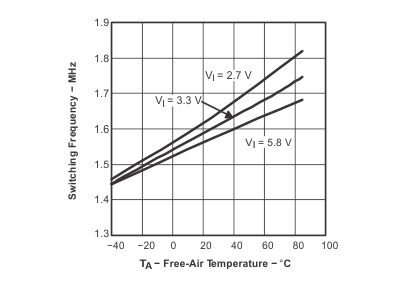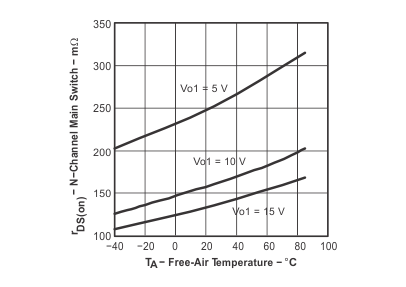SLVS497F SEPTEMBER 2003 – June 2016 TPS65140 , TPS65141 , TPS65145
PRODUCTION DATA.
- 1 Features
- 2 Applications
- 3 Description
- 4 Revision History
- 5 Pin Configuration and Functions
- 6 Specifications
- 7 Detailed Description
-
8 Application and Implementation
- 8.1 Application Information
- 8.2
Typical Application
- 8.2.1 Design Requirements
- 8.2.2
Detailed Design Procedure
- 8.2.2.1
Boost Converter Design Procedure
- 8.2.2.1.1 Inductor Selection
- 8.2.2.1.2 Output Capacitor Selection
- 8.2.2.1.3 Input Capacitor Selection
- 8.2.2.1.4 Rectifier Diode Selection
- 8.2.2.1.5 Converter Loop Design and Stability
- 8.2.2.1.6 Design Procedure Quick Steps
- 8.2.2.1.7 Setting the Output Voltage and Selecting the Feedforward Capacitor
- 8.2.2.1.8 Compensation
- 8.2.2.1.9 Negative Charge Pump
- 8.2.2.1.10 Positive Charge Pump
- 8.2.2.1.11 Linear Regulator Controller
- 8.2.2.1
Boost Converter Design Procedure
- 8.2.3 Application Curves
- 8.3 System Examples
- 9 Power Supply Recommendations
- 10Layout
- 11Device and Documentation Support
- 12Mechanical, Packaging, and Orderable Information
Package Options
Refer to the PDF data sheet for device specific package drawings
Mechanical Data (Package|Pins)
- RGE|24
- PWP|24
Thermal pad, mechanical data (Package|Pins)
Orderable Information
6 Specifications
6.1 Absolute Maximum Ratings
over operating free-air temperature range (unless otherwise noted)(1)| MIN | MAX | UNIT | |
|---|---|---|---|
| Voltages on pin VIN(2) | –0.3 | 6 | V |
| Voltages on pin VO1, SUP, PG (2) | –0.3 | 15.5 | V |
| Voltages on pin EN, MODE, ENR(2) | –0.3 | VI+ 0.3 | V |
| Voltage on pin SW(2) | 20 | V | |
| Power good maximum sink current (PG) | 1 | mA | |
| Continuous power dissipation | See Dissipation Ratings | ||
| Lead temperature (soldering, 10 s) | 260 | °C | |
| Operating junction temperature, TJ | –40 | 150 | °C |
| Storage temperature, Tstg | –65 | 150 | °C |
(1) Stresses beyond those listed under Absolute Maximum Ratings may cause permanent damage to the device. These are stress ratings only, which do not imply functional operation of the device at these or any other conditions beyond those indicated under Recommended Operating Conditions. Exposure to absolute-maximum-rated conditions for extended periods may affect device reliability.
(2) All voltage values are with respect to network ground terminal.
6.2 ESD Ratings
| VALUE | UNIT | |||
|---|---|---|---|---|
| V(ESD) | Electrostatic discharge | Human-body model (HBM), per ANSI/ESDA/JEDEC JS-001(1) | ±2000 | V |
| Charged-device model (CDM), per JEDEC specification JESD22-C101(2) | ±500 | |||
(1) JEDEC document JEP155 states that 500-V HBM allows safe manufacturing with a standard ESD control process.
(2) JEDEC document JEP157 states that 250-V CDM allows safe manufacturing with a standard ESD control process.
6.3 Recommended Operating Conditions
| MIN | NOM | MAX | UNIT | ||
|---|---|---|---|---|---|
| VI | Input voltage | 2.7 | 5.8 | V | |
| L | Inductor(1) | 4.7 | µH | ||
| TA | Operating ambient temperature | –40 | 85 | °C | |
| TJ | Operating junction temperature | –40 | 125 | °C | |
(1) See the application information section for further information.
6.4 Thermal Information
| THERMAL METRIC(1) | TPS6514x | UNIT | ||
|---|---|---|---|---|
| PWP (HTSSOP) | RGE (VQFN) | |||
| 24 PINS | 24 PINS | |||
| RθJA | Junction-to-ambient thermal resistance | 37.2 | 34.2 | °C/W |
| RθJC(top) | Junction-to-case (top) thermal resistance | 18.9 | 35.5 | °C/W |
| RθJB | Junction-to-board thermal resistance | 16.4 | 11.7 | °C/W |
| ψJT | Junction-to-top characterization parameter | 0.4 | 0.4 | °C/W |
| ψJB | Junction-to-board characterization parameter | 16.2 | 11.7 | °C/W |
| RθJC(bot) | Junction-to-case (bottom) thermal resistance | 2.1 | 3.2 | °C/W |
(1) For more information about traditional and new thermal metrics, see the Semiconductor and IC Package Thermal Metrics application report.
6.5 Electrical Characteristics
VI = 3.3 V, EN = VIN, VO1 = 10 V, TA= –40°C to 85°C, typical values are at TA = 25°C (unless otherwise noted)| PARAMETER | TEST CONDITIONS | MIN | TYP | MAX | UNIT | |
|---|---|---|---|---|---|---|
| SUPPLY CURRENT | ||||||
| VI | Input voltage | 2.7 | 5.5 | V | ||
| IQ | Quiescent current into VIN | ENR = GND, VO3 = 2 × VO1, Boost converter not switching |
0.7 | 0.9 | mA | |
| IQCharge | Charge pump quiescent current into SUP | VO1 = SUP = 10 V, VO3 = 2 × VO1 | 1.7 | 2.7 | mA | |
| VO1 = SUP = 10 V, VO3 = 3 × VO1 | 3.9 | 6 | ||||
| IQEN | LDO controller quiescent current into VIN | ENR = VIN, EN = GND | 300 | 800 | μA | |
| ISD | Shutdown current into VIN | EN = ENR = GND | 1 | 10 | μA | |
| VUVLO | Undervoltage lockout threshold | VI falling | 2.2 | 2.4 | V | |
| Thermal shutdown | Temperature rising | 160 | °C | |||
| LOGIC SIGNALS EN, ENR | ||||||
| VIH | High level input voltage | 1.5 | V | |||
| VIL | Low level input voltage | 0.4 | V | |||
| II | Input leakage current | EN = GND or VIN | 0.01 | 0.1 | µA | |
| MAIN BOOST CONVERTER | ||||||
| VO1 | Output voltage | 5 | 15 | V | ||
| VO1 – VIN | Minimum input to output voltage difference | 1 | V | |||
| VREF | Reference voltage | 1.205 | 1.213 | 1.219 | V | |
| VFB | Feedback regulation voltage |
1.136 | 1.146 | 1.154 | V | |
| IFB | Feedback input bias current |
10 | 100 | nA | ||
| rDS(on) | N-MOSFET ON-resistance (Q1) | VO1 = 10 V, ISW = 500 mA | 195 | 290 | mΩ | |
| VO1 = 5 V, ISW = 500 mA | 285 | 420 | ||||
| ILIM | N-MOSFET switch current limit (Q1) | TPS65140, TPS65141 | 1.6 | 2.3 | 2.6 | A |
| TPS65145 | 0.96 | 1.37 | 1.56 | A | ||
| rDS(on) | P-MOSFET ON-resistance (Q2) | VO1 = 10 V, ISW = 100 mA | 9 | 15 | Ω | |
| VO1 = 5 V, ISW = 100 mA | 14 | 22 | ||||
| IMAX | Maximum P-MOSFET peak switch current | 1 | A | |||
| ILEAK | Switch leakage current | VSW = 15 V | 1 | 10 | µA | |
| fSW | Oscillator frequency | 0°C ≤ TA ≤ 85°C | 1.295 | 1.6 | 2.1 | MHz |
| –40°C ≤ TA ≤ 85°C | 1.191 | 1.6 | 2.1 | |||
| Line regulation | 2.7 V ≤ VI ≤ 5.7 V; ILOAD = 100 mA | 0.012 | %/V | |||
| Load regulation | 0 mA ≤ IO ≤ 300 mA | 0.2 | %/A | |||
| NEGATIVE CHARGE PUMP VO2 | ||||||
| VO2 | Output voltage | –2 | V | |||
| VREF | Reference voltage | 1.205 | 1.213 | 1.219 | V | |
| VFB | Feedback regulation voltage |
–36 | 0 | 36 | mV | |
| IFB | Feedback input bias current |
10 | 100 | nA | ||
| rDS(on) | Q8 P-Channel switch rDS(on) | IO = 20 mA | 4.3 | 8 | Ω | |
| Q9 N-Channel switch rDS(on) | 2.9 | 4.4 | ||||
| IO | Maximum output current | 20 | mA | |||
| Line regulation | 7 V ≤ VO1 ≤ 15 V, ILOAD = 10 mA, VO2 = –5 V |
0.09 | %/V | |||
| Load regulation | 1 mA ≤ IO ≤ 20 mA, VO2 = –5 V | 0.126 | %/mA | |||
| POSITIVE CHARGE PUMP VO3 | ||||||
| VO3 | Output voltage | 30 | V | |||
| VREF | Reference voltage | 1.205 | 1.213 | 1.219 | V | |
| VFB | Feedback regulation voltage |
1.187 | 1.214 | 1.238 | V | |
| IFB | Feedback input bias current |
10 | 100 | nA | ||
| rDS(on) | Q3 P-Channel switch rDS(on) | IO = 20 mA | 9.9 | 15.5 | Ω | |
| Q4 N-Channel switch rDS(on) | 1.1 | 1.8 | ||||
| Q5 P-Channel switch rDS(on) | 4.6 | 8.5 | ||||
| Q6 N-Channel switch rDS(on) | 1.2 | 2.2 | ||||
| VD | D1 – D4 Shottky diode forward voltage |
ID1 – D4 = 40 mA | 610 | 720 | mV | |
| IO | Maximum output current | 20 | mA | |||
| Line regulation | 10 V ≤ VO1 ≤ 15 V, ILOAD = 10 mA, VO3 = 27 V |
0.56 | %/V | |||
| Load regulation | 1 mA ≤ IO ≤ 20 mA, VO3 = 27 V | 0.05 | %/mA | |||
| LINEAR REGULATOR CONTROLLER VO4 | ||||||
| VO4 | Output voltage | 4.5 V ≤ VI ≤ 5.5 V; 10 mA ≤ IO ≤ 500 mA | 3.2 | 3.3 | 3.4 | V |
| IBASE | Maximum base drive current |
VIN – VO4 – VBE ≥ 0.5 V(1) | 13.5 | 19 | mA | |
| VIN – VO4 – VBE ≥ 0.75 V (1) | 20 | 27 | ||||
| Line regulation | 4.75 V ≤ VI ≤ 5.5 V, ILOAD = 500 mA | 0.186 | %/V | |||
| Load regulation | 1 mA ≤ IO ≤ 500 mA, VI = 5 V | 0.064 | %/A | |||
| Start-up current | VO4 ≤ 0.8 V | 11 | 20 | 25 | mA | |
| SYSTEM POWER GOOD (PG) | ||||||
| V(PG, VO1) | Power good threshold(2) | –12 | –8.75% VO1 | –6 | V | |
| V(PG, VO2) | –13 | –9.5% VO2 | –5 | V | ||
| V(PG, VO3) | –11 | –8% VO3 | –5 | V | ||
| VOL | PG output low voltage | I(sink) = 500 μA | 0.3 | V | ||
| IL | PG output leakage current | VPG = 5 V | 0.001 | 1 | µA | |
(1) With VI = supply voltage of the TPS6514x, VO4 = output voltage of the regulator, VBE = basis emitter voltage of external transistor.
(2) The power good goes high when all 3 outputs (VO1, VO2, VO3) are above their threshold. The power good goes low as soon as one of the outputs is below their threshold.
6.6 Dissipation Ratings
| PACKAGE | RθJA | TA ≤ 25°C POWER RATING | TA = 70°C POWER RATING | TA = 85°C POWER RATING |
|---|---|---|---|---|
| 24-Pin TSSOP | 30.13 C°/W (PWP soldered) | 3.3 W | 1.83 W | 1.32 W |
| 24-Pin VQFN | 30 C°/W | 3.3 W | 1.8 W | 1.3 W |
6.7 Typical Characteristics
 Figure 1. Switching Frequency vs Free-Air Temperature
Figure 1. Switching Frequency vs Free-Air Temperature
 Figure 2. rDS(on) N-Channel Main Switch
Figure 2. rDS(on) N-Channel Main Switchvs Free-Air Temperature